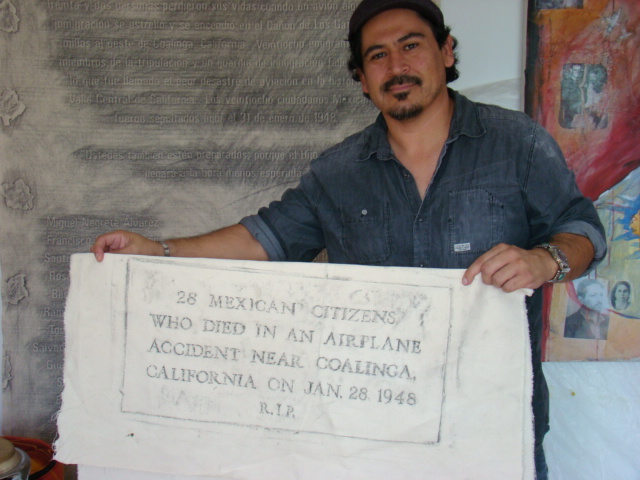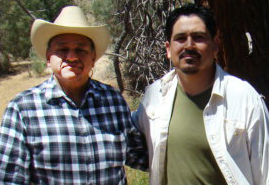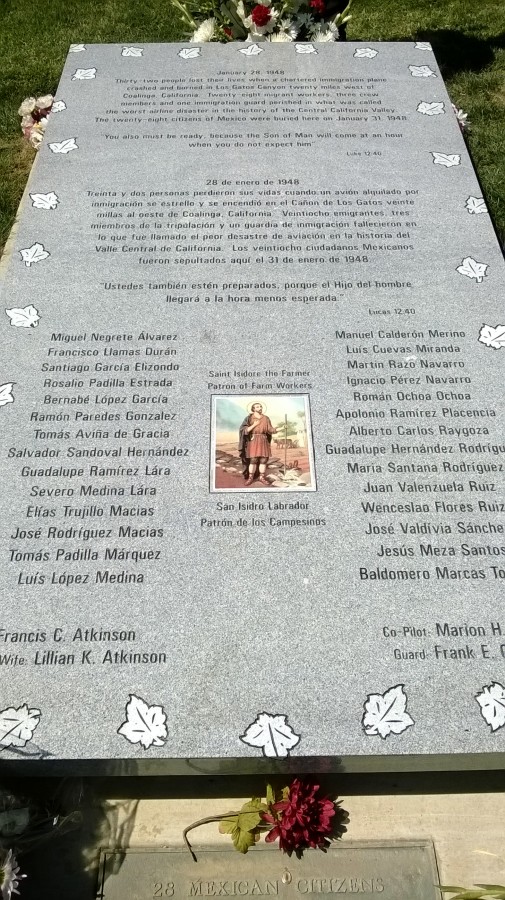EL PASO — Folksinger Woody Guthrie wrote a poem In 1948 about a plane crash that year in which 32 people lost their lives near Los Gatos Creek in the Diablo mountain range of California. The flight was carrying 28 migrant farmworkers who were being deported back to Mexico.
Guthrie was disturbed by press accounts at the time that didn’t include the names of the passengers.
The poem was eventually set to music and was popularized by Pete Seeger as “Deportees,” which included the haunting line: “to fall like dry leaves to rot on my topsoil, and be called by no name except “deportees.”
Sixty-six years later, writer Tim Z. Hernandez has made it his mission to remember those whose lives were lost by finding out their names.

Writer Tim Z. Hernandez holds an imprint of the original headstone from a mass grave for victims of the Los Gatos plane crash that inspired Woody Guthrie’s song “Deportees.’
In 2010, while doing research for his book Mañana Means Heaven, Hernandez, a native of California’s San Joaquin Valley who comes from a migrant farmworker family, came across a headline that read “100 People See An Airplane Fall From The Sky.”
As he continued to read about the incident, Hernandez realized that this plane crash and the crash mentioned in Guthrie’s song were one and the same.
“When I learned that this took place in my backyard, Fresno County, where I’m from, I said I wonder what happened to the people,” Hernandez said.
Hernandez was struck by the fact that only the four members of the the plane crew were named in the article, even though 28 other people died. The Mexican farmworkers – of which only a few actually were illegal immigrants – were collectively referred to simply as deportees.
Hernandez began to investigate the incident in 2013, and, after doing a bit of research online he came across a list of names of the 28 Mexican passengers.
However, Hernandez said, the list was inaccurate and had names on it that didn’t seem right. In some cases they didn’t even sound Hispanic.
Nameless in a mass grave
The biggest discovery was that the farmworkers were buried in a mass grave with a single headstone.
The anonymous placard on the grave read “28 Mexican Citizens Who Died in an Airplane Accident near Coalinga, California on Jan. 28, 1948. Rest In Peace.”
Hernandez decided to write “All They Will Call You,” a book about the tragedy to try to bring attention to those who were forgotten.
Hernandez eventually was able to get a full list of the 28 Mexican citizens. He was eager to begin research for his book, but he also began thinking about getting those names on a new headstone.
Contacting a friend of his at a local newspaper, Hernandez was able to get a story published about his efforts, with the hope that anyone close to the victims would be able to get in touch with him and provide useful information.
Finding the first relative

Jaime Ramirez, left, and Tim Z. Hernandez.
Jaime Ramirez was the first to reach out to Hernandez
“I told him that I was one of the family members that had relatives there. One was my grandfather and the other my uncle,” Ramirez said.
He gave Hernandez an old newspaper sent to him from the Mexican consulate in California detailing the actual burial ceremony listing all of the accurate names of the members of the braceros program who were on the plane.
With the help of Ramirez and some local residents Hernandez was able to raise $10,000 to have a new headstone made with the names of the 32 people killed in the crash.
Ramirez said he visits the crash site each year during Dias de Los Muertos and occasionally brings members of his family that haven’t seen the grave.
Ramirez has also helped Hernandez’ book research by providing some old photos and a letter from his grandfather, one of the victims of the crash.

The new headstone at the mass grave site. Photo courtesy of Tim Z. Hernandez.
Funding the book has been a big challenge for Hernandez who has incurred expenses for travel and records for his research. He is in the final days of an Indiegogo crowdfunding campaign to help with costs.
The next step following the book’s planned publication will be to continue applying for grants and use that money to to create programs to discuss current events regarding immigration issues.
“I want to use this grant money to create programs around dialogue around deportation policies and some of the immigration stuff that’s going on, just kind of use this historical element to talk about what’s going on today,” Hernandez said.
As of this writing, Hernandez has spoken with the families of four of the passengers. He hopes to travel to Mexico in November to speak with three more families.
“The book will be published one day, soon hopefully, and I won’t have found all the families,” he said. “But the book itself, art itself, has its own kind of gravitas. Art, in itself does that, and I believe once the book is out, I’ll end up finding more families because of it.”
